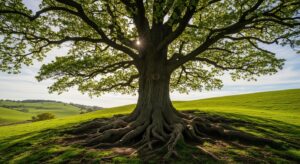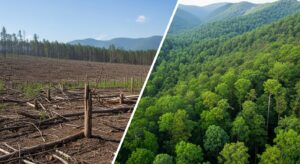🌿 Introduction
Few things embody life and endurance quite like trees. Standing tall through centuries, they clean the air we breathe, cool our cities, and provide food and shelter for wildlife. From ancient rainforests to backyard saplings, trees play a vital role in balancing the ecosystem and enhancing human well-being.
Whether you admire the whispering pines in a mountain forest or the shade of an oak tree in your yard, these green giants remind us of nature’s quiet strength. Let’s dive into how trees sustain our world, their emotional significance, and what we can do to protect them for generations to come.
🌎 1. Environmental Benefits of Trees

Trees are often called the lungs of the Earth—and for good reason. Through photosynthesis, they absorb carbon dioxide and release oxygen, helping combat climate change. A single mature tree can absorb up to 48 pounds of CO₂ each year.
Beyond that, trees filter pollutants from the air, trap dust particles, and provide natural cooling by releasing moisture. Their shade can reduce surrounding temperatures by up to 10°F, making them essential for urban spaces where heat often accumulates.
🌱 Quick Fact:
One acre of forest absorbs enough carbon dioxide to offset the annual emissions of two average cars.
🐿️ 2. Trees as Homes for Wildlife

In every forest and garden, trees form the foundation of vibrant ecosystems. Birds build nests in their branches, squirrels store nuts in their hollows, and insects burrow beneath their bark. Some species depend exclusively on specific trees—for example:
-
Koalas rely on eucalyptus trees for both food and shelter.
-
Monarch butterflies cluster on oyamel firs during migration.
-
Woodpeckers carve out nesting cavities in dead trunks.
When you plant native trees, you help create microhabitats for local wildlife. Even one tree in your yard can serve as a haven for pollinators and small creatures.
🌸 3. The Cultural and Emotional Symbolism of Trees

For centuries, trees have symbolized wisdom, peace, and life. The oak stands for strength, the willow for resilience, and the cherry blossom for renewal. In many cultures, trees are sacred—they represent a connection between heaven and earth.
-
The Bodhi Tree in India is where Buddha attained enlightenment.
-
In Norse mythology, Yggdrasil, the world tree, connects all realms of existence.
-
The olive tree has long been a symbol of peace and prosperity.
Even today, people plant trees to commemorate loved ones or celebrate milestones—living testaments that grow alongside their memories.
🌿 4. Planting and Caring for Trees

Planting trees is one of the simplest yet most powerful actions you can take to benefit the planet. It starts with choosing the right species for your soil, climate, and available space.
🌳 How to Plant a Tree Successfully:
-
Dig wide, not deep — Make the hole twice the width of the root ball.
-
Loosen the roots — Gently untangle roots before placing them in the soil.
-
Water thoroughly — After planting, water deeply to settle the soil.
-
Mulch around the base — Helps retain moisture and prevent weeds.
-
Prune regularly — Remove dead or crossing branches for healthier growth.
Young trees need weekly watering until established, while mature ones can thrive with less frequent care. Over time, you’ll watch your sapling grow into a shade-giving, life-supporting monument.
🏙️ 5. Urban Trees: Nature in the City

In bustling cities, trees serve as green sanctuaries amid concrete. They improve air quality, absorb noise, and provide shade for pedestrians. Studies show that neighborhoods with more greenery report lower stress levels and stronger social connections.
City planners increasingly prioritize urban forests to cool heat islands, prevent flooding, and boost community health. From tree-lined streets to rooftop gardens, urban trees offer beauty and balance in our modern world.
🌆 Example:
Singapore’s “City in a Garden” initiative has integrated greenery into nearly every building, proving that even dense cities can live in harmony with nature.
🌍 6. Trees and Climate Change

As the planet warms, they act as a natural defense system. Forests store massive amounts of carbon in their roots, trunks, and leaves—helping offset emissions from industries and vehicles.
Reforestation and afforestation projects worldwide, like the Great Green Wall in Africa, show how large-scale planting can reverse desertification and improve soil fertility. However, protecting old-growth forests is equally critical—they store centuries of carbon and nurture rare biodiversity.
By supporting eco-friendly policies, using recycled paper, and reducing waste, we help trees continue their vital role in climate stability.
🌱 7. Tree Conservation: How You Can Help

Protecting it doesn’t always require grand gestures—it starts with awareness and small, consistent actions.
🌳 Ways to Support Tree Conservation:
-
Plant native species in your yard or community spaces.
-
Volunteer for local tree-planting or cleanup events.
-
Donate to conservation groups like the Arbor Day Foundation.
-
Advocate for green spaces in urban planning.
-
Educate others about the importance of trees in daily life.
Even small acts of care—like choosing recycled products or avoiding harmful pesticides—can have a ripple effect on global forest health.
🍃 Conclusion
From the whispering canopies of rainforests to the shade trees lining suburban streets, these living pillars sustain life in countless ways. They remind us of patience, strength, and the interconnectedness of all living things.
When we plant and protect trees, we invest in a cleaner, greener, and more balanced future. Whether you’re nurturing a young sapling or admiring an ancient oak, remember that every tree tells a story—and it’s one we all share.